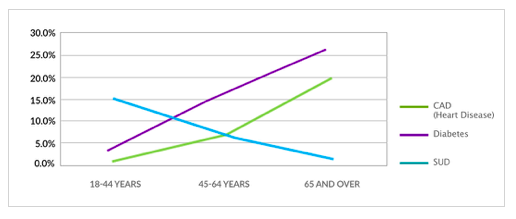Almost nothing you’ve been told about addiction is true – this includes the claim that “addicts can’t quit without treatment” or “you can’t quit drugs on your own.” Over 90% of people with “alcoholism” and more than 96% of people with “drug addiction” will get over their problems, most without ever getting any treatment. The truth matters, and falsehoods (when believed) cause harm. Please take note – rates of addiction and overdose haven’t decreased an iota as our national acceptance of the disease model view of heavy substance use has grown. Things have gotten worse, and this ideology is in large part responsible. This page offers a brief overview of some facts that challenge mainstream addiction and recovery theory, so we can hopefully fix this mess in our culture, or at least some individuals reading this will be better informed to solve their own problems.
[note – I hate the terms “addiction”, “recovery”, and their associated labels. I don’t believe in the disease of addiction, nor recovery from a fake disease. I believe people have substance use problems based in deeply ingrained preferences and habits, but that they are never truly “out of control” (i.e.addicted), and that we can change our substance preferences and habits. Even though we may feel “addicted” we really are freely choosing when we build these preferences and habits, and we are choosing when we change them. The terms “addiction” and “recovery” obscure these facts, so I will put scare quotes around them to indicate my skepticism of the terms, while still succinctly communicating with readers who’d be thrown off by more accurate less succinct language.]
The mainstream view of problematic substance use is that at some point after voluntarily choosing to use drugs too much or too often, the person develops an “addiction.” Once the “addiction” is developed, further substance use is supposedly involuntary, and the person with the “addiction” is incapable of stopping their use of drugs and alcohol without “treatment” for their addiction. There are plenty of pet theories about what causes “addiction” but they all essentially agree that the substance use has become involuntary – that the “addict” is not motivating theirself to desire and use substances, and that they cannot stop by their own powers of choice without treatment of some kind.
The most inconvenient truth for all of the debating about causes of addictions and potential treatments is this: most people get over their “addictions” and yet they never get any treatment for it. The impossible in “addiction and recovery” lore – quitting without help/treatment – is not only possible, but is the norm.
Fact: over 90% of “alcoholics” and over 96% of “drug addicts” will get over their problems.
The US government, through SAMHSA, NIAAA, and other agencies, regularly collects, analyzes, and reports data on drug & alcohol use in the general population. Approximately every ten years since the early 1980s they’ve done a large scale epidemiological survey on addiction (ECA, NCS, NLAES, NESARC). SAMHSA’s National Survey on Drug Use and Health (NSDUH) was started in 1971, and their annual survey reports have been a fountain of insight on substance use for decades. The picture these surveys regularly reveal is that:
Approximately three quarters of americans who’ve ever fit an addiction diagnosis are currently “recovered” from it for a year or more. See page 390 of this brilliant chapter by researcher Gene Heyman for some of these results regarding drugs. See also my coverage of the NESARC results regarding alcohol. Those results show that at the time of the surveys about 75% of people who were “ever addicted” are currently “recovered.” But those are just snapshots, and thus just one part of the story. An even greater percentage will eventually “recover”…
Because of the age trend with “recovery” (at increasing ages, less and less people are “addicted”) epidemiologists are able to calculate the probability that people will get over their substance use problems at some point. When they used the data from NESARC to do this, the resulting probability of “recovery” from “addictions” to various substances are as follows:
- >90% Alcohol
- >96% Prescription Opioids
- >97% Marijuana
- >98% Prescription Tranquilizers and Sedatives
- 99% Prescription Stimulants
- >99% Cocaine
[see citation section 1 at bottom of page]
So you see (and don’t forget it – tell the world!) over 90% of “alcoholics” will get over their problems, and over 96% of people “addicted to” other drugs will get over their problems.
The probability of “recovery” from heroin “addiction” is not offered in any of the papers on NESARC data that I know of. This is probably due to the fact that their sample of heroin users was small. However, 96% of their sample was currently “recovered” for a year or more, which is the same percentage of Vietnam veterans who recovered from heroin “addiction” in 24 year follow up. So all signs indicate the rate is probably close to that offered for prescription opioids above (in the mid 90s).
[note – The BIG wrinkle for heroin is this: currently, we are having a surge in heroin overdoses (due in large part to illicit fentanyl in the heroin supply) so that about 2% of currently “addicted” heroin/opioid users are dying annually. I do not know how to calculate what that means to the overall probability of recovery from these drugs, but half of prescription opioid “addicts” recover within 5 years according to the source above – that might (and I stress might because I am not a statistician) mean something like 10% (2% five times over) will die IF this overdose rate holds. I’ve seen estimates in the past that the average length of a heroin “addiction” is about 6 years. Again, I don’t know how this all figures in, but the probability of “recovery” is still much higher than most people would have you believe – and we know that people can and do “recover” from heroin “addiction” at a rate higher than for alcohol when there is no overdose surge, as the Vietnam vets did. And remember the overdose surge is just that – a surge. It will probably recede as trends in the quality of the black market drug supply have always ebbed and flowed.]
Now back to the bigger point – keep in mind that these probabilities of “recovery” are for all people who fit the diagnoses for “addiction” (Substance Use Disorders / Substance Dependence) in the population – not just those who seek help. In fact, those who seek and receive help are only a fraction of the whole, as you’ll discover in the next fact you need to know…
Fact: most people don’t get treatment for their “addictions” – yet they will still “recover.”
Proponents of addiction treatment regularly complain that “only one in ten addicts get the treatment they need.”
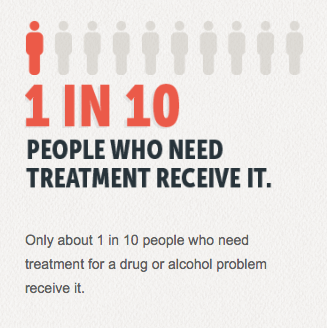
This is basically true – see the pie chart below by SAMHSA:
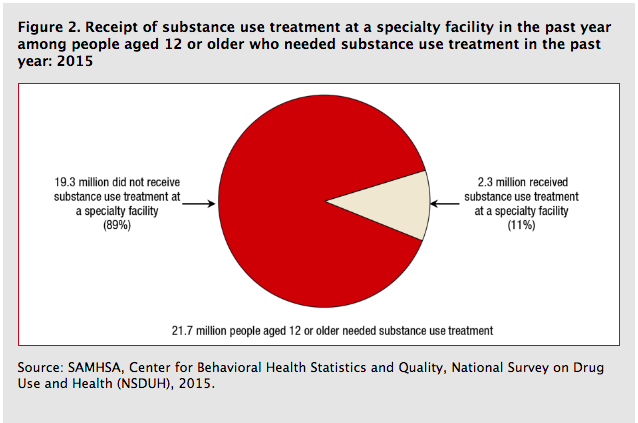
A similar result comes up in these surveys every year, but this is only the percentage of currently “addicted” people who receive treatment in the current year. If you look at how many receive treatment throughout their entire lifetime, the numbers go up a bit. According to statistics from NESARC in both 2001-2002 and 2012-2013, out of all people who’ve ever been “addicted”, somewhere between 14% to 19.8% of “alcoholics”, and 16.2% to 24.6% of “drug addicts” have received treatment at some point in their lives (the higher stats are from the 2012-2013 results). [see citations section 2 at bottom of page for sources of these stats]
Still, this means that only a fraction of people with “addictions” ever get addiction treatment – let’s say it’s about 20% to make it easy (it’s probably lower though since most are “alcoholics” and they have a lower rate of treatment). Only 20% ever get treated, yet upwards of 90% will end their “addictions.” That means that although only 2 out of 10 ever get treatment for their substance use problems, more than 9 out of 10 get over their problems.
That is to say that the vast majority of people get over their “addictions” and they do so without treatment. So when statements such as “only about 1 in 10 people who need treatment for a drug or alcohol problem receive it” use the word NEED, they are factually wrong. They clearly don’t need treatment, as all relevant research indicates people are quite capable, and quite probably will change their problematic substance use habits without ever receiving treatment.
Some readers will think that the success rates would be higher if everyone got treatment. This isn’t true. This isn’t supported by the data. For example, when researchers with the data for both NESARC and NLAES (a similar survey done 10 years before NESARC), compared the eventual outcomes between those who’d received treatment for alcohol dependence and those who hadn’t, the rates of success were similar. In NESARC data, 28.4% of the treated group and 23.8% of the untreated group were still dependent on alcohol. So, results were similar, with untreated “alcoholics” faring slightly better. The same was true in NLAES, where 33.2% of the treated group, and 25.8% of the untreated group were still dependent on alcohol.
We don’t have as much data comparing treated and untreated groups for other drugs, yet we also have no reason to suspect the results should be any different. The vast majority of users of all drugs get over their “addictions” even though only a small minority get treatment. But the next objection to what I’ve said here is the idea that treatment would speed up the “recovery” process. This isn’t supported by the data on alcohol in NESARC and NLAES. Take for example the chart below, which offers no evidence that “alcoholics” will “recover” any quicker if they receive alcoholism treatment. I put this together from the NLAES data which broke down the results by how long it’s been since a person’s alcohol problems began. Over time, most treated and untreated “alcoholics” got over their problems pretty steadily, treated or not.
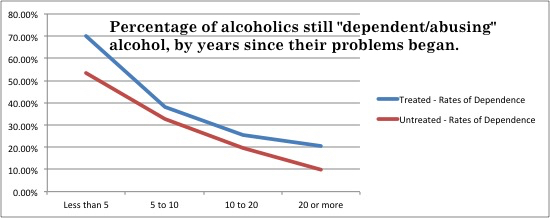
The results are similar for NESARC ten years later, and you can see a detailed table of that data here, which demonstrates that over time the untreated group does far better, with 13.6% of the treated group and 4.3% of the untreated group “still dependent” at 20 or more years since their alcohol dependence began. In both NESARC and NLAES, untreated group does better over time. This indicates that treatment could be hampering the “natural recovery” process.
Another potential objection to this data that I’ve heard often is that it might just be catching people in a temporary period of recovery, and that they probably relapse the next year. After all, they say, “addiction is a chronic incurable disease.” This simply isn’t true, as the trends for age in these surveys repeatedly demonstrate that rates of “addiction” decrease with age. Since “addiction” is often said to be a “chronic condition like diabetes or heart disease” we compared the rates of these conditions by age in The Freedom Model for Addictions: Escape the Treatment and Recovery Trap, see the chart below:
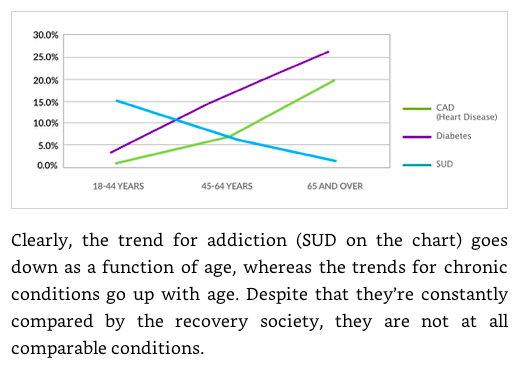
In some technical sense, since “addictions” usually last more than 6 months, they are “chronic” – but not “like diabetes and heart disease” at all, because “addictions” are not lifelong. Some people stop and start and struggle for a while, but there comes a time when most people permanently get over their “addictions.” That’s why it goes down with age – while rates of diabetes and heart disease go up with age as more people are added to and stay in the pool of people experiencing these real diseases for the rest of their lives.
The idea of “permanent recovery” of course clashes with the experience of devoted 12 Step group members. Many will tell you that it’s a constant struggle to keep themselves from using drugs/alcohol “addictively.” First, you need to know that although they are the most visible and outspoken “recovering” people (they become the addiction & recovery activists, counselors and other treatment staff, and gurus that dominate the discourse on “addiction”), devoted 12-step members are a tiny minority of people who’ve ever had “addictions.” Most addiction treatment involves the 12 steps. Although most of the 2 million people who receive treatment every year are made to go to 12 step meetings as part of their treatment, the group’s membership is not growing, because most people don’t like it and drop out of it very quickly (in 2012 AA estimated worldwide membership at 2.1 million, today in 2018 they say it’s “over 2 million” – in the US alone, it’s likely that 10 million people have been directed into the group from treatment between 2012-2018- but they aren’t sticking around). Myself and others have estimated that devoted 12-Step members constitute less than 1% of currently “recovering/recovered” people. So here’s the point: they are an extremely tiny minority of people who ever “recover”, and they attend meetings daily where they talk about how hard of a lifelong struggle it is; they describe themselves as addicts and alcoholics every day; they discuss drugs and alcohol every day; they talk about their “incurable disease” every day; they discuss ways to avoid triggers and relapsing every day – because this is all the informally required discourse of a devoted 12 step member. Of course they feel like it’s a lifelong struggle – our feelings come from the way we see our life (that’s CBT 101). That they feel like it’s a lifelong struggle doesn’t make it true. It doesn’t have to be a lifelong struggle, and definitely is not for most. Take their protests for what they truly represent – the subjective feelings of a tiny sliver of people with substance use problems who’ve been persuaded to remind themselves every day that they will never get over their problems.
Now back to the big points – Important to remember with this data is that even though the majority of people who receive treatment will eventually “recover” we can’t honestly say that treatment caused them to “recover.” Post-treatment “relapse” rates are notoriously high. All we know about people in such epidemiological surveys is that they did receive treatment at some point – not whether or not it “caused” them to reduce or quit using substances. In fact, what the data suggest is that those who received treatment would’ve gotten over their problems without treatment. Since addiction research rarely uses placebo or control groups, this data on untreated “addicts/alcoholics” is the closest thing we have to a good placebo group. And, when a placebo group does as well or better than the group who received an active medication/treatment, it suggests the treatment has no net positive effect. When talking to people who’ve gotten over their substance use problems, you’ll find that they often did it long after they received treatment, in ways that had nothing to do with treatment (deliberation and choice!). I am one such person, but in epidemiological data like this, I’d be in the group who received treatment and might be counted as a treatment success story – even though I ended up worse off every time I was treated for my substance use problems. I KNOW that I am not alone in this, I get email from people with similar stories all the time.
Furthermore, people who get over their “addictions” with or without treatment are all doing it the same way – they are realizing their lives can be better and happier if they use substances less, and then they are choosing to do that.
The Bottom Line:
Nobody needs treatment for addiction. Some may need treatment for withdrawal syndrome, but that is not “addiction” treatment, it’s treatment for a medical condition caused by heavy substance use. Most people – >90% of “alcoholics” and >96% of “addicts” – will get over their problems with or without treatment. Most (75-80%) won’t EVER get treatment and will still get over their problems, at a rate equal to or better than that of those who receive treatment. Now, this wasn’t covered in depth in this article, but I can confidently tell you that there is no support for statements such as “some people need treatment and some don’t”, because there is no support for theories such as the disease model of addiction, or “loss of control.” People labeled as “addicts and alcoholics” are fully in control of their substance use. I go into depth on these issues in The Freedom Model for Addictions: Escape The Treatment and Recovery Trap which I wrote with Mark Scheeren and Michelle Dunbar of The Freedom Model Retreats.
Please tell everyone you know that anyone is fully capable of getting over their substance use problems, because it is the truth. Tell them it is within their power to do even if they don’t get treatment. Tell the people who struggle that you know they can do it! Tell them to be optimistic because well over 90% eventually do get over their problems! Tell them it doesn’t have to be a lifelong struggle where relapse is expected – because it’s true!
One final important note!
My intention is not to say that “addicts and alcoholics” cannot be helped, nor do I mean that it’s bad to want or get help, nor do I mean to convey that they should just wait to magically change. We can help people with substance use problems, asking for help doesn’t make you less than people who don’t, and the change will ALWAYS be initiated and carried out by the person with the problem (i.e. waiting for change to magically happen without any kind of effort will lead to nothing). However, I don’t think treatment is particularly helpful; in fact I think it’s often counterproductive. But “help” isn’t just treatment. Help can come in many forms. It is a choice to change, and to make that choice, we have to look at our substance use options differently and arrive at the conclusion that a change would make us happier. There are infinite ways to do this, as evidenced by the millions of people who continue to overcome their substance use problems. I offer one way in my book. Effective help needs to contribute to the individual’s decision-making process, and I’m sure there are also infinite ways to offer such help to people.
CITATIONS:
(1) – Sources on probability of recovery from various drugs:
Blanco, C., Secades-Villa, R., García-Rodríguez, O., Labrador-Mendez, M., Wang, S., & Schwartz, R. P. (2013). Probability and predictors of remission from life-time prescription drug use disorders: Results from the National Epidemiologic Survey on Alcohol and Related Conditions. Journal of Psychiatric Research, 47(1), 42–49. https://doi.org/10.1016/j.jpsychires.2012.08.019
Lopez-Quintero, C., Hasin, D. S., de los Cobos, J. P., Pines, A., Wang, S., Grant, B. F., & Blanco, C. (2011). Probability and predictors of remission from lifetime nicotine, alcohol, cannabis, or cocaine dependence: Results from the National Epidemiologic Survey on Alcohol and Related Conditions. Addiction (Abingdon, England), 106(3), 657–669. https://doi.org/10.1111/j.1360-0443.2010.03194.x
(2) – Sources on receipt of treatment:
Hasin, D. S., & Grant, B. F. (2015). The National Epidemiologic Survey on Alcohol and Related Conditions (NESARC) Waves 1 and 2: Review and summary of findings. Social Psychiatry and Psychiatric Epidemiology, 50(11), 1609–1640. https://doi.org/10.1007/s00127-015-1088-0
Perron, B. E., Mowbray, O. P., Glass, J. E., Delva, J., Vaughn, M. G., & Howard, M. O. (2009). Differences in service utilization and barriers among Blacks, Hispanics, and Whites with drug use disorders. Substance Abuse Treatment, Prevention, and Policy, 4, 3. https://doi.org/10.1186/1747-597X-4-3
Grant BF, Goldstein RB, Saha TD, & et al. (2015). Epidemiology of dsm-5 alcohol use disorder: Results from the national epidemiologic survey on alcohol and related conditions iii. JAMA Psychiatry. https://doi.org/10.1001/jamapsychiatry.2015.0584
Grant, B. F., Saha, T. D., Ruan, W. J., Goldstein, R. B., Chou, S. P., Jung, J., … Hasin, D. S. (2016). Epidemiology of DSM-5 Drug Use Disorder: Results From the National Epidemiologic Survey on Alcohol and Related Conditions-III. JAMA Psychiatry, 73(1), 39–47. https://doi.org/10.1001/jamapsychiatry.2015.2132
